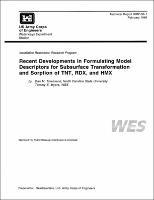Please use this identifier to cite or link to this item:
https://hdl.handle.net/11681/4827| Title: | Recent developments in formulating model descriptors for subsurface transformation and sorption of TNT, RDX, and HMX |
| Authors: | North Carolina State University Installation Restoration Research Program (U.S.) Townsend, Daniel M. Myers, Tommy E. |
| Keywords: | Explosives Breakthrough curves RDX TNT HMX Sorption Transformation Groundwater Bioremediation |
| Publisher: | Environmental Laboratory (U.S.) Engineer Research and Development Center (U.S.) |
| Description: | Technical Report Abstract: Subsurface contamination with 2,4,6-trinitrotoluene (TNT), 2,3,5-trinitro-1,3,5-triazine (RDX),and oxyhydro-1,3,5,7-tetranitro-,3,5,7-tetrazocine (HMX) is a problem at military installations where these explosives were manufactured or used in loading munitions. Recent laboratory batch and column studies conducted to identify processes affecting subsurface transport of TNT, RDX, and HMX provide new informationon the relative significance of transformation and sorption for these explosives and yield estimates of key process descriptors. This report assesses the current state of knowledge regarding subsurface transformation and sorption of TNT, RDX,and HMX,provides estimates for subsurface transport descriptors, and recommends further research. Transformation and sorption are important processes in the subsurface transport of TNT, RDX, and HMX. Measurement of transformation products has provided unequivocal evidence of TNT transformation. Research has also indicated that RDX and HMX are affected by subsurface transformations, but RDX and HMX transformation products have not been measured due to lack of chemical analytical capability. The order to magnitude of transformationis TNT >> RDX ≈ HMX, and the order of magnitude of sorption in TNT > HMX > RDX. Sorption of TNT by soils has been described with equilibrium-type approaches, although there is substantial evidence that TNT transforms to the extent that equilibrium, at least in batch, is not attainable under reducing conditions. Equilibrium sorption parameters for TNT may be no more than fitting parameters that compensate for inadequately formulated transformation/sorption kinetics. Therefore, caution is advised when extrapolating laboratory-based equilibrium sorption parameters for TNT to field situations. The available data indicate that TNT transformation is a first-order process and is highly dependent on redox conditions. RDX sorption is equilibrium controlled and can be modeled using a linear isotherm. RDX transformation appears to be first order and slow relative to TNT. Limited information on HMX suggests that HMX sorption may be nonlinear (if equilibrium controlled) or may not be equilibrium controlled. HMX transformation appears to be first order and slow, like RDX. Finally, of the three explosives (TNT, RDX, HMX), formulation of field models for RDX subsurface transport is anticipated to be the least complicated, since RDX sorption is a linear equilibrium process and RDX transformation is slow and probably first order. HMX transport modeling may be more complicated due to nonlinear or nonequilibrium sorption. TNT-transport modeling is complicated by potentially rapid transformation, depending on redox conditions, and competition with transformation products for sorption sites. |
| Rights: | Approved for public release; distribution is unlimited. |
| URI: | http://hdl.handle.net/11681/4827 |
| Appears in Collections: | Technical Report |
